Easy Peanut Butter Cookies Recipe
This classic recipe for peanut butter cookies comes straight from my mom’s recipe box, and they are the BEST peanut butter cookies. They are easy to make and stay wonderfully soft. This staple recipe deserves a place in everyone’s kitchen!
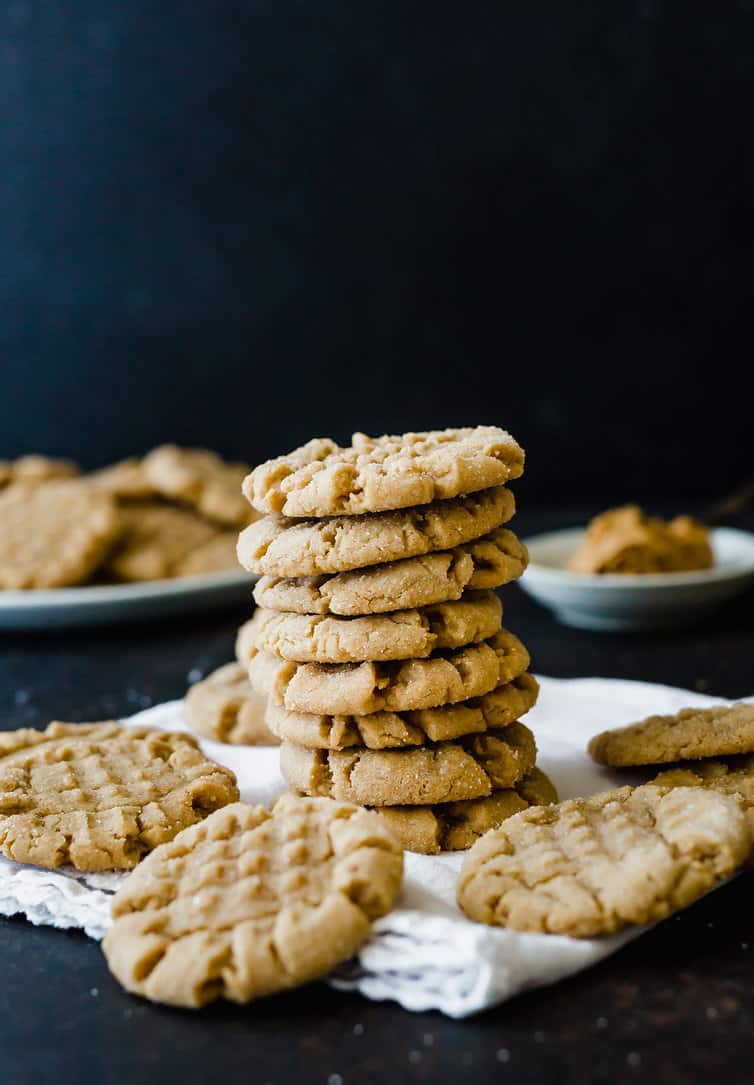
When you think about what would be on the all-star team of cookies, I think it breaks down pretty simply to the following:
- Chocolate chip cookies
- Peanut butter cookies
- Sugar cookies
- Oatmeal raisin cookies
Sure, there are tons of other amazing cookies out there (hello shortbread, thumbprint, snickerdoodles, snowballs, and macaroons, to name a few), but these four are the essentials (and then of course there’s the trifecta of peanut butter-oatmeal chocolate chip cookies). They’re the cookies that always show up on cookie trays, the ones that everyone’s family has multiple recipes for, are easy to whip up, and evoke the most nostalgic cookie memories.
Of these, I’ve always had the softest spot for peanut butter cookies. There’s just something about those crisscross-laced cookies loaded with peanut butter and rolled in crunchy sugar that makes me remember sitting in my mom’s old kitchen and licking the beaters, helping her roll those balls of dough and pressing the tines of a fork on top.
I might be biased, but I think these are the BEST peanut butter cookies!
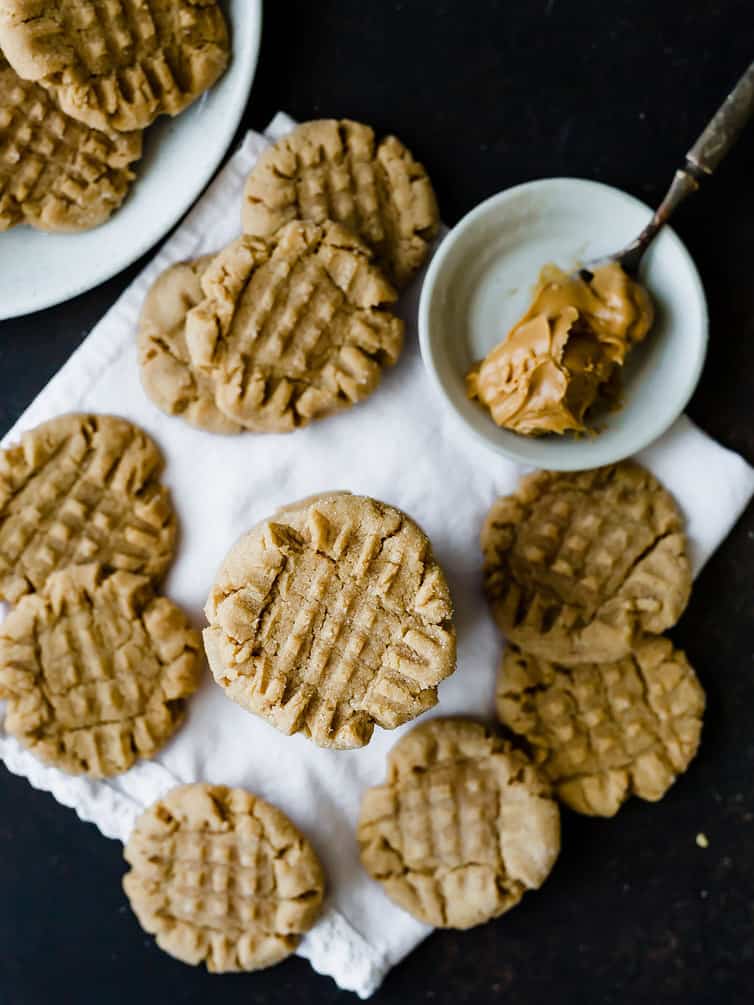
This is the recipe my mom made with me and my sister when we were little and it was the first recipe I begged her for after I left home. I would venture to guess that it came from the back of a jar of peanut butter back in the day, but she doesn’t have a source listed anywhere.
It’s a simple list of ingredients – flour, baking soda, salt, peanut butter (of course!) brown sugar, shortening, milk, and vanilla. It takes all of five minutes to mix them together, then you roll the dough into tablespoon-size balls of dough, roll them in granular sugar, then press the tines of a fork in a crisscross pattern on top.
They are incredibly easy to make and belong on every single Christmas cookie tray, wedding cookie table, and after school snack plate from now until the end of time.
Why the criss-cross pattern on top?
Good question! That crosshatch is a defining trait of nearly all peanut butter cookies.
Peanut butter cookie dough is a bit dense, so pressing down on them helps to flatten them a bit so they bake more evenly. And, bonus! Since this is a traditional characteristic of peanut butter cookies, you’ll always be able to spot them on a cookie tray without having to ask what kind of cookie it is.
Making this pretty pattern is incredibly easy – dip the tines of a fork in sugar, gently press it into the top of the cookie, then repeat, this time making the impression perpendicular to the first. You did it!
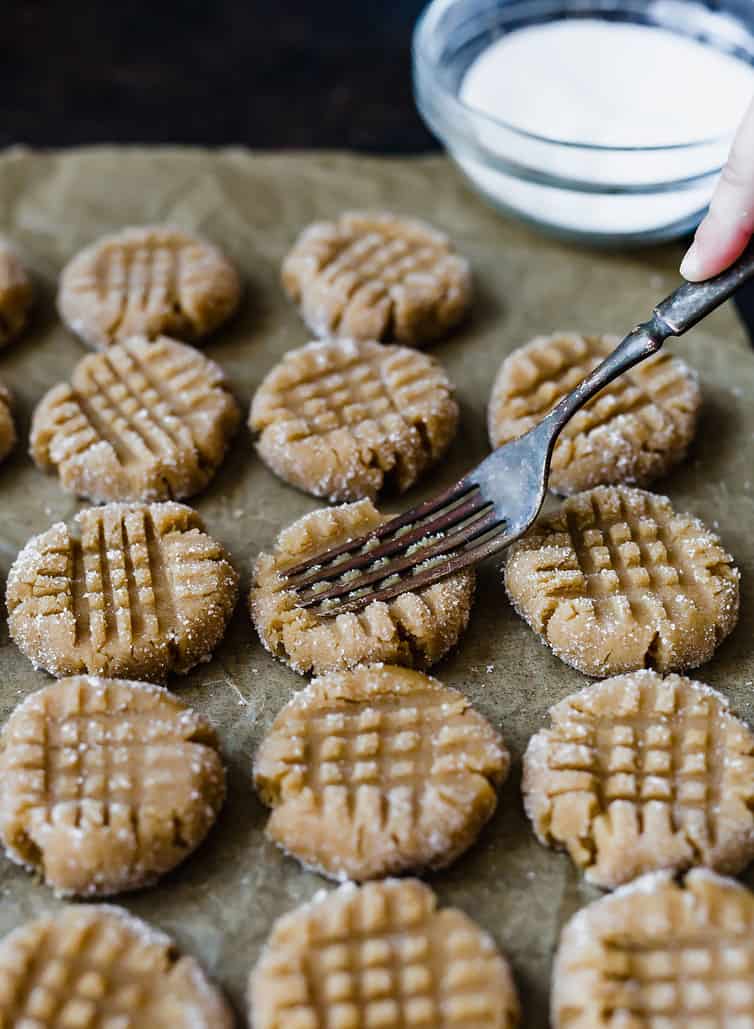
The best kind of peanut butter to use
I always, always recommend only baking with creamy, processed peanut butter, such as Jif, Skippy, or Peter Pan. Natural-style peanut butter with oil separation is simply too greasy for nearly all baking recipes; using it can result in cookies that spread too much and that can become crumbly.
If you’d like to use a nut butter alternative, see the recipe notes below on some recommendations.
Tips for measuring peanut butter
Peanut butter can be sticky and hard to get into and then back out of a measuring cup when baking. I have a few suggestions for making it easier!
- Weigh your ingredients – You know I’m a big advocate of this and have an entire post dedicated to why you should weigh ingredients when baking; all you need to do is scoop it out of the jar and plop it in your bowl – no messing around with measuring cups!
- Use an adjustable measuring cup – An adjustable measuring cup allows you to set the amount to measure, fill it up, and dispense it into the bowl. This is a great tool for sticky ingredients like peanut butter, honey, molasses, etc.
- Grease your measuring cups – Last but not least, you can coat your measuring cup with non-stick cooking spray to help it slide right out after it’s been measured.
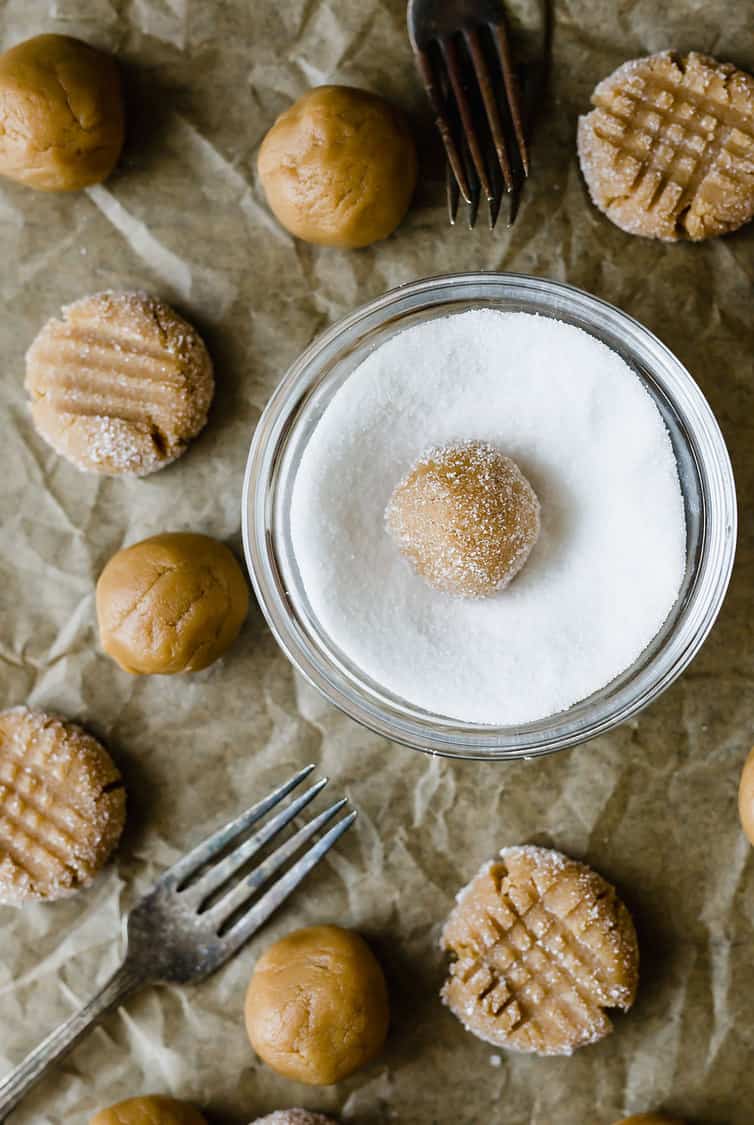
Recipe Tips & Notes
- Preparing your pans – Whether you use cookie sheets or rimmed baking sheets, be sure that your sheets are ungreased or lined with parchment to keep the cookies from spreading and absorbing too much grease.
- Can you use butter instead of shortening? In a word, no. Shortening keeps the cookies from spreading too much, keeps them from being crumbly, and ensures that they are nice and soft. Replacing it with butter would significantly alter the texture of the cookies and I beg you not to do it. They do now make butter-flavored shortening that I’ve used from time to time if you’re worried about the flavor.
- Peanut Butter – It is important to use traditional, processed peanut butter (i.e. Jif, Skippy, Peter Pan, etc.) in this recipe. Using natural peanut butter that has oil separation will be much too greasy and cause the cookies to spread and become crumbly, so I do not recommend using natural peanut butter.
- Nut Butter Alternatives – You can use other nut butters such as almond butter, cashew butter, etc. as long as they do not have oil separation (see the note above). A great almond butter substitute that works exceptionally well in all baked goods I’ve tried it with is Barney Butter.
- Avoid crumbly cookies – The three most common reasons peanut butter cookies end up crumbly are (1) too much flour; (2) using the wrong kind of peanut butter, and (3) they are overbaked. Be sure to either weigh your flour or spoon it into your measuring cup before leveling (the scoop method often results in too much flour), use the correct type of peanut butter (see above), and take the cookies out when the centers still look soft and underdone. They will set as they cool.
- Fun Extras – You can jazz these cookies up a bit if you’d like! Try rolling in colored sugars for a festive look or add some mix-ins – try a ½ cup of chopped peanuts, mini chocolate chips, peanut butter chips, butterscotch chips, or any other mix-in you like to pair with peanut butter!
- Make-Ahead – You can prepare the cookie dough and refrigerate for up to 3 days before baking. When ready, let it sit on the counter for about 30 minutes before scooping and proceeding with baking.
- Storage – These cookies will keep in an airtight container at room temperature for up to 1 week.
- Freezing Instructions – These cookies freeze exceptionally well! You can freeze the balls of dough in a ziptop plastic bag for up to 3 months. Remove from the freezer, let sit at room temperature for 30 minutes, then roll in sugar and make the crisscross pattern on top, then bake as directed, adding an extra minute. You can also freeze the baked cookies by wrapping them individually in plastic wrap, then place them in a ziptop bag and freeze for up to 3 months.
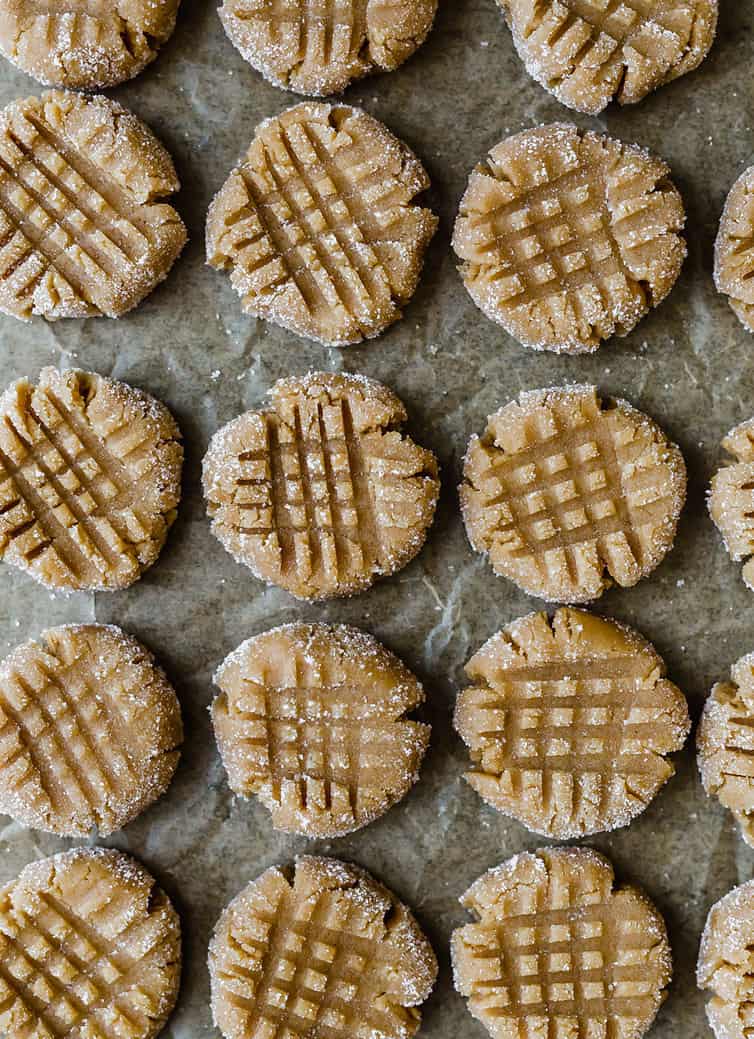
Variations on classic peanut butter cookies
While regular ol’ peanut butter cookies are fantastic on their own, these variations deserve a spot in your recipe box, too:
- Monster Cookies – Peanut butter cookie dough PLUS oats, chocolate chips, M&Ms, and Reese’s Pieces!
- Peanut Butter Blossoms – A holiday classic! Place the sugared balls of dough on a cookie sheet and press a Hershey’s kiss into the center when they come out of the oven.
- Peanut Butter Cup Cookies – Take that ball of dough, pop into a mini muffin pan, then press a mini peanut butter cup into the centers when they come out of the oven.
- Salted Peanut Butter Cup Chocolate Chip Cookies – A riff on my favorite chocolate chip cookies, these have a peanut butter dough base, are super thick and soft, and loaded with peanut butter chips, milk chocolate chips, and chopped peanut butter cups.
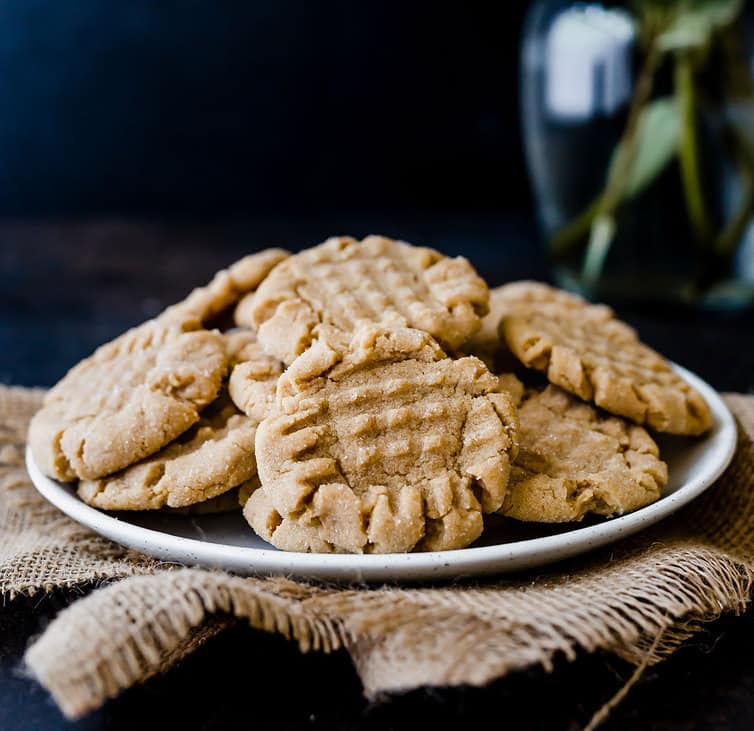
Watch How to Make Peanut Butter Cookies:
If you make this recipe and love it, I would so appreciate it if you would take a moment to leave a rating below. Thank you so much! ❤️️
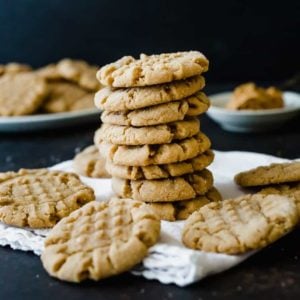
Easy Peanut Butter Cookies
Ingredients
- 1¾ cups (218.75 g) all-purpose flour
- ¾ teaspoon (0.75 teaspoon) salt
- ¾ teaspoon (0.75 teaspoon) baking soda
- ¾ cup (193.5 g) creamy peanut butter
- ½ cup (102.5 g) vegetable shortening
- 1¼ cups (275 g) packed light brown sugar
- 3 tablespoons milk
- 1 tablespoon vanilla
- 1 egg
- Granulated sugar, for rolling cookies
Instructions
- Preheat oven to 375 degrees F. Line baking sheets with parchment or a silicone baking mat.
- In a small bowl, whisk together the flour, salt and baking soda.
- In a mixing bowl, combine the peanut butter, shortening, brown sugar, milk and vanilla. Beat at medium speed until well blended, about 2 to 3 minutes. Add the egg and beat just until blended. Reduce speed to low and add the dry ingredients to the creamed mixture gradually, mixing just until combined.
- Put the granulated sugar in a small bowl. Scoop a tablespoonful of dough and roll into a ball between the palms of your hands. Roll the dough into the sugar and place on the baking sheet, about 2 inches apart. Dip the tines of a fork into the sugar and make a crisscross pattern on the cookies, flattening them slightly.
- Bake for 7 to 8 minutes or until set and just beginning to brown. Cool 2 minutes on baking sheet before removing to a wire rack to cool completely. The cookies can be stored in an airtight container at room temperature for up to 1 week or frozen for up to 3 months.
Notes
- Preparing your pans – Whether you use cookie sheets or rimmed baking sheets, be sure that your sheets are ungreased or lined with parchment to keep the cookies from spreading and absorbing too much grease.
- Can you use butter instead of shortening? In a word, no. Shortening keeps the cookies from spreading too much, keeps them from being crumbly, and ensures that they are nice and soft. Replacing it with butter would significantly alter the texture of the cookies and I beg you not to do it. They do now make butter-flavored shortening that I’ve used from time to time if you’re worried about the flavor.
- Peanut Butter – It is important to use traditional, processed peanut butter (i.e. Jif, Skippy, Peter Pan, etc.) in this recipe. Using natural peanut butter that has oil separation will be much too greasy and cause the cookies to spread and become crumbly, so I do not recommend using natural peanut butter.
- Nut Butter Alternatives – You can use other nut butters such as almond butter, cashew butter, etc. as long as they do not have oil separation (see the note above). A great almond butter substitute that works exceptionally well in all baked goods I’ve tried it with is Barney Butter.
- Avoid crumbly cookies – The three most common reasons peanut butter cookies end up crumbly are (1) too much flour; (2) using the wrong kind of peanut butter, and (3) they are overbaked. Be sure to either weigh your flour or spoon it into your measuring cup before leveling (the scoop method often results in too much flour), use the correct type of peanut butter (see above), and take the cookies out when the centers still look soft and underdone. They will set as they cool.
- Fun Extras – You can jazz these cookies up a bit if you’d like! Try rolling in colored sugars for a festive look or add some mix-ins – try a ½ cup of chopped peanuts, mini chocolate chips, peanut butter chips, butterscotch chips, or any other mix-in you like to pair with peanut butter!
- Make-Ahead – You can prepare the cookie dough and refrigerate for up to 3 days before baking. When ready, let it sit on the counter for about 30 minutes before scooping and proceeding with baking.
- Storage – These cookies will keep in an airtight container at room temperature for up to 1 week.
- Freezing Instructions – These cookies freeze exceptionally well! You can freeze the balls of dough in a ziptop plastic bag for up to 3 months. Remove from the freezer, let sit at room temperature for 30 minutes, then roll in sugar and make the crisscross pattern on top, then bake as directed, adding an extra minute. You can also freeze the baked cookies by wrapping them individually in plastic wrap, then place them in a ziptop bag and freeze for up to 3 months.
Did you make this recipe?
Leave a review below, then snap a picture and tag @thebrowneyedbaker on Instagram so I can see it!
[photos by Whitney Wright]


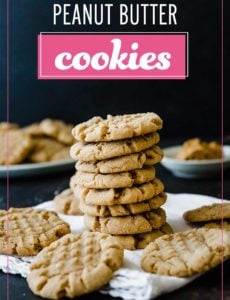



It’s not a bad cookie it’s just more of a brown sugar cookie than peanut butter. It’s a very faint peanut butter taste and I even cut back on the Brown Sugar by a quarter of a cup because I don’t like super sweet stuff. I wouldn’t make it again if I wanted a peanut butter cookie.
I have been a fan for years and now using a new email, your recipes never fail to please my grandkids! Thank you, best wishes to you and your family.
Linda
Best Peanut Butter Cookies Ever!
Can I substitute gluten free flour and almond milk??
EXCELLENT RECIPE!!
Please try it, it’s really a no fail recipe!
The cris crossed on the cookie is so people know it is a nut cookie peanut but r we so it let’s people with allergies to not eat
I’ve often wondered where the traditional crisscross pattern on peanut butter cookies came from.
My daughter’s comment: Because it looks like the shell of a peanut.
It does!
After the cookies cool, I melt a cup of chocolate chips and dip one side of each baked cookie into the melted chocolate. Place back on the cookie sheet until set.
The recipe notes say don’t use parchment paper on the cookie sheets but the instructions in the recipe say line the sheets with parchment paper. Which is the correct instruction?
Hi Beth, The notes say to use an ungreased pan OR line it with parchment paper.
I made these for my 33y.o. son after not making peanut butter cookies for at least a decade. The judgment was your recipe was delicious and better than he remembers my efforts during his childhood. I rolled the dough in a larger grain sugar to try it and my and his girlfriend thought the balance of sweet and salt was perfect! Also, loved the metric, weights, made it so easy. Thank you for a great, easy recipe, no photo taken as all the cookies went home with the 30+ y.o.’s❤️👏🥇
This was also my mother’s peanut butter cookie recipe. I loved it…they are my favorite cookies!! Thank You for sharing!!
Our family loves butter biscuits. We made this recipe at home and found the best. Delicious biscuits are ready. I now intend to make this recipe for my son’s wedding as well. Thanks to the recipe maker.
Everybody talks about how great soft, chewy cookies are. Fact is, If I bite into a soft cookie it gets spit out faster than the strained peas my Mom fed me 68 years ago.
Can ANYBODY tell me how to make crispy, crunchy peanut butter cookies that give a mouth pleasing snap when bitten?
My Mom used to make the best damned Peanut butter cookies!
Thanks in advance!
Jim Stinson, try adding some white cake mix to your cookie mix, that will make them more crispy. then adjust flour, or google crispy peanut butter cookies
good luck!
Great cookies! You can easily halve the brown sugar and they are still delicious and sweet.
Perfect. Simple. Delicious. I always have the best of luck with your recipes. I will try some mix-ins next time.
Update: I slightly over cooked the last 1/2 batch- they were still yummy!!!
So simple and easy I loved them
Thank you for the alternate nut butters to try. Kiddo with peanut allergy and nice to let them know some of life’s yummy things! 😊
You’re welcome! I totally understand, we’re an allergy house here :)
I also prefer to weigh my ingredients. It would be helpful if you would include the weight along with the measurements in your recipes.
Thank you for your interesting site.
Louise
Hi Louise, The weights are included. If you click the link that says “metric” underneath the ingredient list, the measurements are converted to weights. I am working to make this more streamlined so the weights can appear next to the cup measurements.
I am trying to use recipes with weights of ingredients provided for more consistent success. Could you please provide weights for this recipe?
Hi Theresa, Yes, weights are included. If you click the link that says “metric” underneath the ingredient list, the measurements are converted to weights. I am working to make this more streamlined so the weights can appear next to the cup measurements.
Easily the most requested thing I bake and it is thanks to this recipe! Follow her instructions to a T and you are guaranteed the best results. I played with the bake time as I do with all of Michelle’s recipes. In my oven I need to bake for 9 minutes but I think I make my dough balls just a little bigger than instructed.
I have invested in a scale as the results of weighing my ingredients significantly improves the quality of my baked goods. It also cuts down on dishes! Nothing is worse than trying to clean shortening out of a measuring cup.
Amazing, wonderful, delicious… If you have tried this recipe GO DO IT.
Hi Michelle. I discovered your wonderful baking blog just this Friday. I wanted to try to make bread for the first time and I made your Italian bread. It was the best dough and bread ever! So tonight I decided to bake the peanut butter cookies, and once again, I am equally impressed at the way my baking improved with your guidance and recipes. Thank you, please keep up this wonderful sharing.
Donna
I am saddened to hear that you and your family have been harassed and that some feel you should comment on current events. I personally enjoy that you have kept us up to date on your family and the children’s growth without getting off the baking theme. Keep up the good work.
Delicious and will make again! Mine did spread a little, so next time may put the batter in the fridge before baking.
Please do not change the format of your blog. Some people have such a sense of false bravado shielded by a computer screen. Does not necessarily mean they have the right to tell you what to do.
My mom taught me another way of measuring sticky solids like shortening and peanut butter. Use a larger measuring cup, and make up the difference with water. For example, if you want 3/4 cup of shortening, use a 1-cup measuring cup, add 1/4 cup water, add shortening (pressing it level with the top of the cup) until the water reaches the top of the cup, pour off the water, and add the shortening to your mixing bowl.
Who says you’ll never use what you learned in science class?
I appreciate any pf your posts. Updated, revamped, new….old. revamped, or updated reminds me how much I like that recipe or item. I’d rather see an updated classic again…nostalgia, fond memories…thank you for being such a gracious classy lady.
I tried four recipes before I settled on this one. I usually send cookies to a local nursing home. These cookies are a frequent request. They are tender and yet a bit crispy and sandy. Very good!
Im stuck inside because of this covid-19 and decided to make some cookies. This recipe was simple with ingredients I had in my pantry. Absolutely delicious!! I did use half shortening and half butter. Crispy on the edges and soft in the middle. I’ll be making these again.
I love your recipes and always have success. I like a crispy cookie rather than soft and chewy and wondered if I could achieve that by substituting white sugar instead of brown?
Hi Kathy, I’ve never tried that, but it’s worth a shot!
Fantastic recipe. My go to for peanut butter cookies!!!
I like peanut so much. Peanut butter cookies, just wow and yammi…
I tried these and absolutely loved them!!! I think I found my new go-to peanut butter cookie recipe! Thanks!!!
Love your photography. May I ask what camera you use?
Great tips! Especially about using shortening. These cookies look amazing!
These look exactly like the cookies my mama made when I was a kid. I can’t wait to try these!
Yum, my honey loves peanut butter cookies.. I can’t wait to try this version for him!
I just summed the article…did not see the part that said to not use butter. I used butter. The batter was a bit too moist, so I added a little more flour. Cookies did not spread out as I feared they might. They cooked just right and came out soft and buttery. Delish!
Everyone loved these cookies! I reduced the sugar and subsitiuted coconut oil for shortening
INCREDIBLE.
This will be my PB cookie recipe for life.
Thanks!
Added Mini Reese’s Pieces and milk chocolate chips. AMAZING!!
You don’t say how much shortening to use in your peanutbutter cookies And im ready to make these as I send this
Hi Kathy, It is in the ingredient list – 1/2 cup.
thank you for the p/cookie recipe; my hubby’s favorite cookie
Looking at the video for Peanut Butter Cookies. What shortening do you use?
Hi Brenda, I use regular Crisco shortening. Enjoy!
I haven’t made peanut butter cookies in decades! My eldest is your age and I’m pretty sure I haven’t made them since she’s been on the planet. That needs to be remedied soon!
what brand of peanut butter do you use for these cookies?
Hi Jen, Jif and Skippy are my favorite for baking!
I made your PB Oatmeal CC cookies just yesterday..so delicious. I substitute Trader Joe’s mini peanut butter cups for the chocolate chips. The more peanut butter flavor the better is my philosophy. The only problem is that the container holds more litte cups than the recipe calls for so the tempation to eat the leftovers is very hard to resist.
I was just looking at peanut butter cookie recipes for the kids and I to make. I remember standing by my mom making the crisscross pattern with my fork. My kids love to help so this sounds like a great recipe to try.
I love peanut butter cookies! These look so delicious!
is 375 degrees in Fahrenheit or Celsius? I’m also assuming its 1 3/4 cup of flour?
Hi Nur, It’s Fahrenheit, and yes, cups! I will make those edits :)
A family member asked for peanut butter cookies. I did not have a good recipe, so of course I turned to you. As always you came through for me. These cookies are terrific. They are delicious, and they stay soft. Thank you for another keeper.
Thank you for this recipe. I have been looking for a recipe for peanut butter cookies that didn’t use butter or margarine and yours was perfect. The only problem I had was I was a little short on the vanilla only had about 3/4 tbs. Will be making this again when I have more vanilla
These were really delicious! Thank you! If any one is afraid of shortening, I use palm oil shortening which is all vegetable oil and non-hydrogenated (and contains no trans fat). My favorite is an organic one made by Spectrum which I get in my local Fred Meyer. Admittedly, I don’t use it a lot, but there are some recipes which are difficult to replicate without it, and so far it acts exactly like hydrogenated shortenings (as it contains no water like butter does). Recently I’ve read that palm tree oil may be contributing to rain forest woes. Sigh. You just can’t win! At least I use it very sparingly.
hi i was wondering if these would come out the same if i used carton egg whites instead of whole eggs?
she carton says that 3 tbs of egg whites = 1 whole egg in baking.
do you think they will still come out as good?
You mentioned that you thought the recipe might have been from a corporation because the ingredients were name brand. I just Googled “Crisco peanut butter cookies” and the first result was “Irresistible Peanut Butter Cookies” on Crisco’s website. All the ingredients and quantities were identical to your mom’s recipe, so you were right. Not using butter seems unforgivable, but I suppose you could compromise and use butter-flavored Crisco, eh?
Loved these cookies! But next time will be using 1 cup of peanut butter instead of 3/4 cup. Needed just a touch of a more peanut butter taste. Felt like the peanut butter was competing with the sugar. Thanks for the receipe.
When I needed a good peanut butter cookie recipe the first place I thought to look was your site. You didn’t disappoint! What an easy and tasty recipe for peanut butter cookies. I defiantly will be adding this to my cookie arsenal for the holidays. Thank you!
Hi! I’m planning on baking these cookies this week, but only have Golden Brown Sugar on hand. How do you think this will affect the cookie in terms of taste and texture compared to light brown sugar?
Hi CeeCee, I have never used golden brown sugar, so I couldn’t say definitively how it might alter the cookies.
when to add the cry ingredients? I assume after the eggis blended, but it is missing from the recipe.
thanks
Hi Phyllis, Yes, you are correct, my apologies for the error, I will edit that immediately.
Hi. I switched out the peanut butter for homemade toasted pecan butter. The taste was amazing but since the pecan butter is on the thin side the cookies flattened a bit. I thought to maybe add a little more flour, or possibly put the sugared dough balls in the freezer for 10 minutes?
help?
Hi Will, Unfortunately, homemade nut butters don’t take as well to baking as commercial peanut butter. I would definitely add more flour, and refrigerating may not hurt, either.
These cookies are great!! After they cooled I sprinkled a little confectionary sugar on the top, made them look really pretty..
I just made these, except swapped out the shortening for equivalent in butter (1/2 c) Just wanted to let peeps who do not want to use the shortening know that they came out yummy and tasty still. Not too crumbly – held together and had a rich peanut-y taste :) Thanks for the great posts!
My husband said, “I could go for some chewy peanut butter cookies.” And I knew exactly where to look. ;)
Just made these. Yes, irresistible!
This is the same recipe that’s on my Crisco package (except for your step to roll dough in sugar). It calls for Jif peanut butter, Crisco, and Pillsbury brand flour. I’ll bet that’s where your mom got it too! Mine are in the oven now. :)
I try to avoid feeding my family partially hydrogenated oil, but once in a while we do consume it, and I have shortening in my pantry for the occasional cookie recipe like this one. Thank you for giving us the choice. I love your recipes and your blog.
OMG!!!! Thanks for the recipe. I used butter instead of shortening. these cookies came out awesome and are so delicious!!!!
These are by far some of the most beautiful PB cookies I have seen or made! Lovely for holiday gift giving!
I just made these today, and let me say, the DOUGH tasted amazing! I only let myself have a sweet treat a couple of times a week right now on my new diet, so I haven’t tried the actual cookies yet. But, they came out soft in the middles and a little bit crunchy on the edges, not brown though after the 7 minutes. Mine were larger than a tablespoon though. I imagine if the dough tastes good, the baked cookies will also. Using shortening makes them stay chewier.
These are the most yummy peanut butter cookies EVER! I did not use shortening, but a stick of butter and my cookies still came out moist. Also, I made them into sandwich cookies using my own chocolate buttercream filling. My husband and son LOVE them! LOVE your recipies!
I just tried out this recipe tonight before dinner. Like someone else said, it looks to be the same as the recipe inside the Butter Flavored Crisco box. Turned out great! I added just a splash of Bailey’s Creme Brulee coffee creamer that we have in the fridge (been adding that to EVERYTHING lately, so why not? Hah) and it seemed to add a bit of an extra rich flavor. I also substituted a small amount of the shortening for butter (not much at all, maybe a tablespoon or 2). I always love my peanut butter cookies to be crispy but with a nice bendable tender chewy snap, and these did not disappoint! The first batch was more puffy and crispy, and I flattened the 2nd batch a little more to get the texture I really wanted. Came out great!
Made these a couple weeks ago, and received bundles of compliments. Good work! Plan to make them again tonight or tomorrow. Thanks so much for all the great recipes :)
I just made these…was looking for a recipe with brown sugar (not white). Love these. I know what you mean about the consistency changing without shortening…I can’t stand to use 1/2 cup so I used 1/4 cup butter, 1/4 cup shortening…Perfect! Thanks for the recipe!
Aha, finally! I lost my recipe for the peanut butter cookies I used to make back in the 50s. The recipe was from my grandmother and try as I might I haven’t been able to duplicate it. Your recipe isn’t the same, but it’s close. Shortening rather than butter is definitely part of the answer as is pure peanut butter, but my recipe had lemon juice in it and I think that added a little something extra. I’m going to try it again adding some lemon juice to see what happens. Anyway, these are going to keep me in ecstasy for the time being.
Hi, great blog, I’m just about to start making these. But there’s no measurement for the flour? It only says 1 3/4 flour….. Is it cups? I hope so, that’s what I’m gonna count on :P Can’t wait to try more of your recipes
Hi Kristine, I am so sorry! Yes, that should be cups. I am correcting it right now.
Wow. Just came out of the oven. Took a bite and died and went straight to peanut butter heaven. Enough said.
Simply cannot wait to try these..as peanut butter cookies or peanut butter fingers were always my favorite after-school drool….
Question…Could I substitute saindoux (here in France) or organic white lard (in English) for the shortening? I’ve heard it has the same effect in baking…and makes for light end results? Intrigued by any insight you or your readers might have!
Hi Donna, I think you would be okay substituting lard, it does have very similar (although not identical) properties to shortening.
i made these the other day and i substituted the shortening for butter. They turned out a bit dry, is this cos i used butter instead of shortening? they were still really good i added chocolate chips to some of them
:) really tasty!
Yes, using butter in place of shortening would cause the cookies to be more crumbly and dry.
WOW! These cookies are AMAZING!!! I am *not* a baker (this was my first time attempting to make peanut butter cookies) and these were so incredibly simple! My kids are loving them :) Thank you!!!!
I just made the cookies and they were great, you were right about the shortening I have tried to make some before with butter and they were to crumbly but I didn’t know why thank you so much it is my go to recipe when I want peanut butter cookies!!!
First, I love this recipe! Shortening doesn’t scare me at all. It is now the only pb cookie recipe I use. But…..I can’t help but notice that it is the exact recipe on the Jiff jar…and there is a Jiff advertisement banner across the top of the screen. Is that a random event?
Hi Morgan, This recipe has been in my mom’s recipe book since I was a kid, but it’s very possible she got it from the JIF jar. The ad at the top is definitely a coincidence; Foodbuzz manages the ad inventory that shows up on my site, I don’t hand select it or anything.
Wooow, these look amazing!!!
It’s a shame I can’t find peanut butter here… Do you think I could make some?
Absolutely! I have never done it, but have heard of many people who do it regularly.
I have used many of your recipes, including this one. I did compare this before I made them to an old family recipe. Hate to say, these are better. Perhaps you can explain something to me. In the other recipe it called for 3 cups of flour — or 2 if you want a richer cookie. I don’t understand what this means. Would they be softer or harder with less flour? I have never been good with chemistry. That is another reason I enjoy your site —- you have done all the work. Appreciate any insight you can provide…. thanks, sue g
Hi Sue, With less flour, there is a more dense, rich and concentrated flavor. It’s a big reason why flourless chocolate tortes are so popular – super rich!
Splenda is a wonderful substitute for sugar. Splenda bake is what I use. Might want to try it if you have a love one who is diabetic.
These looked great and I decided to make them for my peanut butter loving husband! While they tasted great, the dough was difficult to work with. They were super crumbly and I could not roll them into balls at all. Hoping I just forgot an ingredient…I’ll be trying these again soon, hoping they’re better next time, because these came together easily and quickly!
These cookies are awsome! I bake cookies every year to give out to our good customers at Christmas time. I already tried the Better-than-Brownie cookies and they were a hit with my kids and husband. For these peanut butter cookies I tried them with chopped dry roasted peanuts mixed into the dough. I then dipped the balls in chopped dry roated peanut and then rolled in large crystal sugar ( I used Demerara sugar). Thanks for the great recipes. I enjoy your website.
Oooh love your additions to this recipe, need to try those adaptations this year!
This is the exact recipe that I got from the package of Butter Flavor Crisco sticks. It’s a good one.
Peanut butter yummy…I just pulled a batch of these from the oven and they’re just perfect. I have another peanut butter cookie recipe and those cookies turned out so dry and crumbly, almost like a peanut butter shortbread but these cookies are so soft and chewy! I’m home alone so I’m gonna have to seriously control myself tonight…but these cookies are just so darn good!
Hi Michelle! I was looking back at some of your cookie recipes, and I recognized this instantly! I am 98% certain that your mom wrote down the recipe from the jar of JIF peanut butter! The big size that you buy in the wrapped 2-pack – yep I eat that much peanut butter! This is probably the first cookie recipe I took the initiative and cooked completely on my own – and I still love it! I have definitely added Reece’s pieces to the mix before too!
My mom has a recipe that calls for mapeline instead of vanilla. I want to dig it out and try it! It’s pretty irresistable. I absolutely love your snickerdoodles! I rolled some in cinnamon sugar and some in sprinkles. My kids LOVED them! So glad I found you!
I am so excited that I found this recipe. My Mother-In-Law (who has passed away) gave me this recipe about 30 some years ago. When I just went to use it the ink had run on the paper and some things were missing. I looked at every PB cookie on all sites and none of them were the exact ingredients. I finally saw this site and could not believe every ingredient and every step was the same as her recipe. This is a wonderful PB recipe. I am so glad I kept looking till I found it. I was just about ready to give up. Thank you!!
I made this over the weekend and they were amazing! Shortening can’t scare me away! :)
These were perfect. I used Butter-Flavored Crisco. The perfect texture, so good.
Hiamyj – So glad you enjoyed these, thanks for letting me know! :)
I just made these cookies, super easy and YUM!
As you say, it looks irresistible and I’m not sure I would resist too long before making this recipe!
Man these look fabulous and shortening is in my favorite ginger cookie recipe, it just does the trick sometimes.
Alice, how funny about your mom growing up on a farm and using shortening! But I agree with you – for some recipes, there’s just no replacing. I tend to draw the line when the recipe calls for the shortening to be melted. Melted shortening?! Blech! The original recipe for the pizzelle I just posted called for melted shortening, so I used butter.
You are too funny!
I’ve been looking for a good peanut butter cookie for years, I’ll give these a try. I know what you mean about the shortening, I’ve made a few older family recipes for my blog that call for shortening,it’s embarassing, but there’s just no replacing it.
i just got a hold of my grandma’s old recipe book, probably from the 40s and 50s, full of shortening…so funny, I was thinking great, my grandma’s old recipe book, everybody seems to have old family recipes on their blogs, now I have some to share, open my book and it’s full of shortening… I can’t use any of it! ha ha! I asked my mom if there was a butter shortage when she was a kid…I thought she grew up on a farm???
These look delicious – great job! (I’ve missed commenting on your blog for a bit so it’s so good to have some time and catch up with all your cooking/baking! :) )
They look perfecto! Got us craving pb cookies now.
Michelle – So glad that you enjoyed these!
Cookin’ Canuck – I love peanut butter cookies rolled in sugar. Some recipes don’t call for it (this original didn’t) but I always do it!
I love that you added the step of rolling the cookies in the sugar before baking. They look so beautiful & I’ll bet the sugar adds a great crunch.
Update…..I just made these (I told you I would), and they are fabulous!
I love peanut butter and I love cookies so I would love these. Toss in some M&M’s or Reese’s Pieces and I am set!
Heidi – I agree with Crisco in moderation. I don’t put it in everything, so some recipes here and there I am okay with, especially when I notice a big difference in texture if I don’t use it. And glad to hear Cook’s Illustrated gave the trans fat version a thumbs up!
I was just thinking PB cookies would be a great thing for my kids and I to bake together because there is nary a chocolate chip in my cupboard, but I always have peanutbutter. BTW, Crisco in moderation doesn’t scare me, but I just read that Crisco has a new ‘0 trans fat’ version and Cook’s Illustrated gives it the ‘thumbs up’.
Michelle – Perfect timing! I hope you enjoy them!
I was just craving peanut butter cookies last night, I think I will make these today!
Delicious!!! I suggest chopped peanuts instead of half of the peanut butter
Liz – You’re right, Crisco is shortening.
I TOTALLY get random cravings. I’ll print recipes that sound good and then it takes forever to actually make… but then I’ll see a recipe on a blog and be like “I NEED to make this TONIGHT” haha so good!
Wow I meant Crisco. I really know nothing about shortening. Obviously.
yes Crisco is vegetable shortening
So is shortening like, Crico? I’ve never used it…
Oooh yes, I too get random cravings, haha :-D Peanut Butter cookies are another nostalgic favorite of mine (like the pizzelles)!!
I have cravings for PB all the time, that’s when I run to the jar with a spoon! Shortening makes me shudder, but my pb cookies do get kind of crumbly. I might try subbing some in next time. Even though they got rid of the transfats, Crisco still tastes like plastic. I hope the Pens win tmr!!
I substitute Organic Coconut oil in a jar for all recipes calling for shortning . It is much healthier and you don’t taste it in the peanut butter cookie recipe! I do chill my cookues briefly before baking. They turn out great.